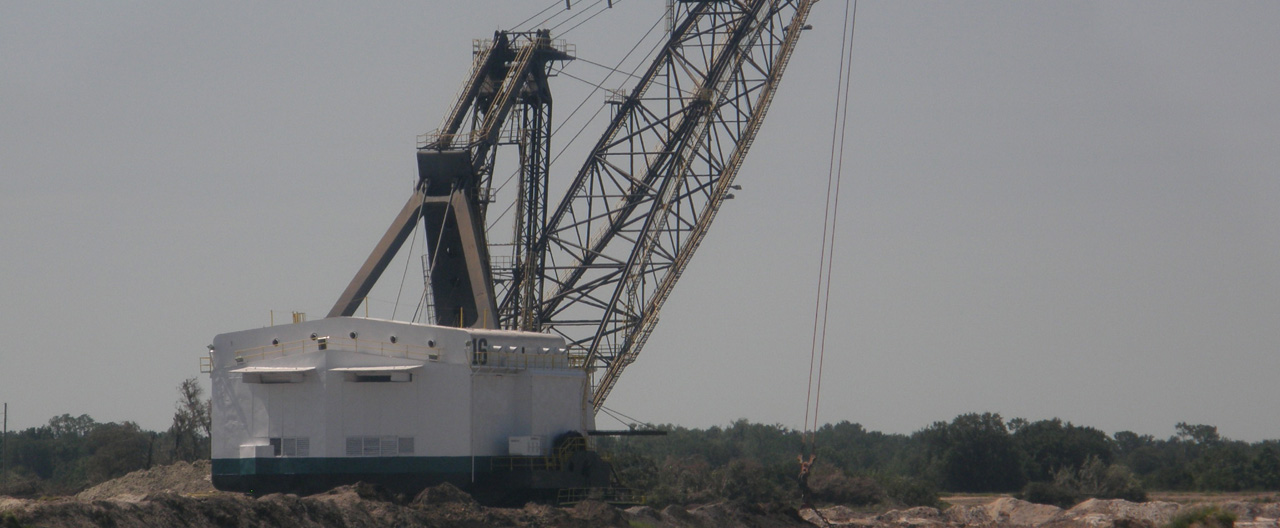Phosphate and How Florida Was Formed
Florida is blessed with a bountiful supply of phosphate that primeval seas deposited here millions of years ago. The phosphate comes from sediment that was deposited in layers on the sea floor. The phosphate rich sediments are believed to have formed from precipitation of phosphate from seawater along with the skeletons and waste products of creatures living in the seas.
In the early 1800s, it was learned that phosphorus promotes growth in plants and animals. At first, bones, which contain the element phosphorus, were used as an agricultural fertilizer. Today, phosphate rock provides fertilizer’s phosphorus.
Phosphate rock was first mined in England in 1847 for use as a fertilizer. It was in 1881 that Captain J. Francis LeBaron, of the Army Corps of Engineers, discovered Florida’s treasure in black phosphate pebbles in the Peace River. A “hard rock” phosphate reserve in North Central Florida was discovered next. Thus began Florida’s phosphate mining industry. Florida’s phosphate mining today accounts for about 80% of the phosphate used in the United States, as well as about 25% of the phosphate used around the world.
The Florida that we know today and the phosphate buried in its earth is a relatively recent product of geologic processes that have been at work for a long time.
In the 1960s, scientists introduced the theory of plate tectonics. This theory holds that the Earth’s crust is fractured into several large pieces called plates. These plates move around very slowly, propelled by powerful forces deep within the Earth. As the plates move, the continents are carried along on top of them as if they were passengers on a raft. Sometimes continents are split up – other times they are brought together. Throughout the long history of the Earth, this process has rearranged the continents many times.
Evidence from core samples obtained from deep wells drilled around the state indicates that the igneous and metamorphic rocks that Florida is built on may once have been part of Africa. These rocks became joined to North America more than 300 million years ago during the formation of the “super continent” that scientists call Pangaea. When Pangaea broke apart into the continents we know today, these deep “basement rocks” that underlie the state remained with North America.
Over the millions of years that followed, thousands of feet of sedimentary rock deposits accumulated on top of the underlying rocks to build up the land we see today. During this time, most of what is now Florida was underwater. Marine creatures in the form of coral, shells and skeletons deposited the limestone that makes up the sedimentary layers. As time passed, sea level dropped and the limestone became exposed as land.
Florida’s phosphate rock deposits are believed to have originated in several ways. Some of the phosphate may have formed when conditions in the seawater caused dissolved phosphorus to solidify, a process scientists call precipitation. As material settled to the bottom of the shallow coastal waters, it became part of the sedimentary layers that eventually formed the sediment that is mined today. It is also likely that excrement and sea life remains played a big part in forming the deposits. Bones, teeth, and other animal remains also contributed to the ore formation.
By about 12 million years ago, most of the coastline of Florida probably looked much like it does today in many coastal areas. In those times, however, the shoreline was located up to 60 miles further inland. In the shallow waters offshore a layer of clay and sandy limestone was deposited. Today this layer is known as the Hawthorn Formation.
Rivers and streams flowed down to the sea, carrying material washed from the land. This material was deposited in shallow lagoons and bays along the coast, forming deposits of sand and clay. These deposits contain the remains of land animals brought in by the rivers and streams, and also marine creatures that inhabited the coastal waters. These deposits are so rich in fossils, the term scientists use for evidence of ancient life, that they are known as the Bone Valley Formation. In Central Florida, the Bone Valley Formation is found on top of the Hawthorn Formation and is under about 20-40 feet of sand.
Fossils from the sedimentary deposits of the Bone Valley Formation are often uncovered in the process of phosphate mining and give us a glimpse of Florida’s prehistoric past. Bone Valley is the heart of Florida’s phosphate mining area.
Among the abundant fossils found in Florida are those from the sea creatures that lived in the shallow waters that covered Florida in the distant past. These fossils include the teeth of giant sharks and the bones of huge whales (both on display at the Mulberry Phosphate Museum). The remains of hundreds of species of land animals, birds, and plants are also found in the layers of rock beneath the present day surface. These fossils include many species that came to Florida to escape the advancing glaciers of the great Ice Ages. Some of these animals migrated to North America from other parts of the world. For example, some of these animals came across the Bering Strait land bridge from Asia when sea level was lower. Others traveled around the rim of the Gulf of Mexico, when areas that are now submerged were exposed.
Other evidence tells us that Florida supported this great variety of creatures with abundant food supplies made possible by a temperate climate. Fossilized remains dug from the Earth during phosphate mining tell us a great deal about the life of the past and about early geological developments in Florida.
